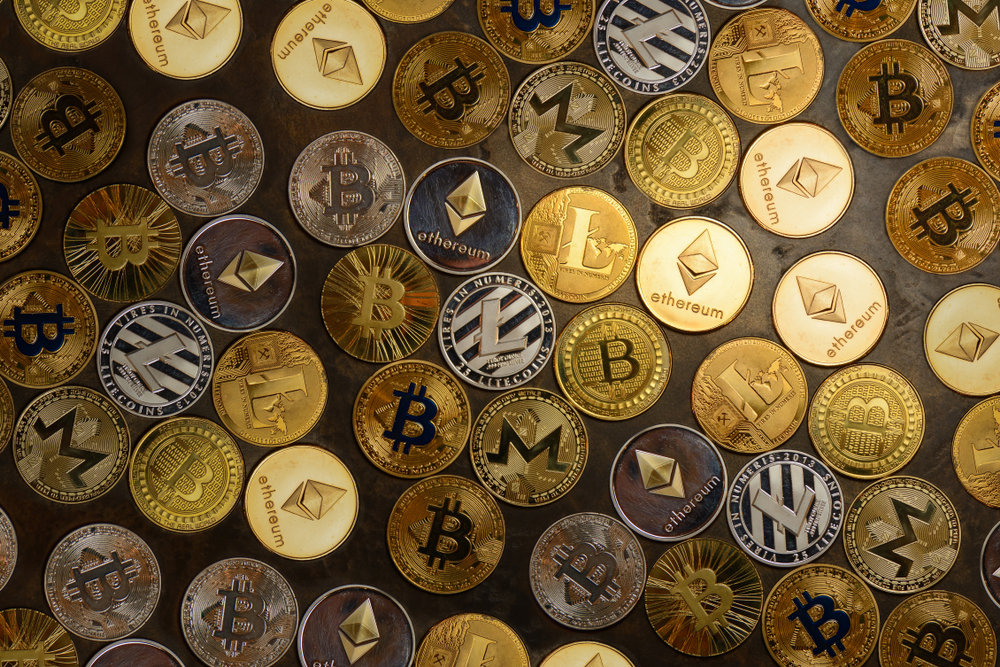Altcoins and Stablecoins are the pillars of the crypto market. However, there are some key differences between both these types of coins, and we’re going to learn more about these differences in this guide.
Except for Bitcoin, every other cryptocurrency is termed “Altcoin.” Altcoins hold a significant share of the crypto market, and every altcoin competes against Bitcoin for market dominance. Just like Bitcoin, altcoins can also be traded on major cryptocurrency exchanges.
In this guide, we’re going to explore the differences between altcoins and stablecoins, especially the ones currently in use.
Stablecoins, on the other hand, are known for their price stability in the crypto market. No matter how volatile the crypto market might become, stablecoins try to keep their value constant. For example, USDT is pegged to the US dollar and keeps its price at $1, no matter how volatile the crypto market might be.
Stablecoins can be pegged to any asset for their price. However, most of the stablecoins have their value attached to the USD. Developers of a stablecoin can also link the coin to another cryptocurrency to replicate its value.
Altcoins vs. Stablecoins: Major Differences
The key differences between altcoins and stablecoins come in their functionality and price. While altcoins can fluctuate abruptly with the volatile crypto market, stablecoins provide the crypto market with some stability and act as a hedge. Stablecoins are backed by fixed reserves of the same asset they’re pegged to. This is how they maintain a fixed price in the long run.
The key difference between altcoins and Bitcoin is that altcoins provide additional functionalities and make easy access to DeFi applications possible. In addition to this, altcoins can provide faster and cheaper transactions and introduce smart contracts as well. These features aren’t available in Bitcoin.
Just like Bitcoin, altcoins suffer from high levels of volatility. The biggest altcoins use Bitcoin’s algorithm and introduce necessary changes to it to capture a huge market. This is how altcoins like Ethereum can provide their investors with handsome ROI.
On the other hand, the stability of stablecoins comes at the cost of ROI. Interest rates of stablecoins can go up to 20% per annum. This is why these coins are still an attractive investment choice for many investors.
Stablecoins have lots of other advantages as well, which make them one of the best investment vehicles in the cryptocurrency field for traders who are just starting.
Although stablecoins do not provide their investors with high returns, their price stability is essential in radio transactions, in which speedy transactions are needed to ensure profitability.
Is ETH an Altcoin?
When we take a look at Ethereum’s TVL (total value locked) and trading volume, it comes out as the most utilized and traded altcoin. ETH is the native token of the Ethereum blockchain.
Many experts distinguish ETH from other altcoins, as it is the first-ever cryptocurrency with blockchain technology implemented into it and the first one with smart contract functionality. This is why Bitcoin and Ethereum are termed as the two equal rulers of the crypto market by many.
Regardless of its market shares and functionality, Ethereum is an altcoin.
Since altcoins and stablecoins differ in their functionality and price, the advantages of holding both of them differ greatly. Investors usually keep a mix of altcoins and stablecoins in their investment portfolios. Usually, altcoins are a better choice for investors with more risk appetite. A diverse investment portfolio ensures a perfect balance between liquidity and high ROI.
Introduction to Altcoins
There are lots of altcoins being introduced into the crypto market these days. Here’s when investors should focus on investing in altcoins.
One of the main reasons to invest in altcoins is that BTC and ETH have become overly expensive and out of the reach of common investors. On the other hand, smaller altcoins have low market caps and make for more suitable investments. This is how altcoins can provide new investors with more profit with smaller investments.
By investing in cheap altcoins, investors can benefit more from their rapid price fluctuations. Many investors keep an eye on newly launched altcoins and make quick investment decisions to make high profits. However, this type of investment is very risky.
Short-term traders can choose altcoins for their short-term trades and profits. There are lots of altcoins short-term investors can invest in. Altcoins are available on every major crypto exchange in the market.
The Altcoin Season
Generally, investors invest in altcoins whenever Bitcoin surges in price. This is termed the altcoin season. Moreover, whenever Bitcoin price goes down or becomes stable, many investors move their investments into altcoins to keep benefiting from the price fluctuations.
Whenever the cumulative market cap of the top 50 altcoins outperforms the market cap of Bitcoin, that period is considered the altcoin season. The altcoins need to outperform Bitcoin for 90 days straight for the altcoin season to start.
There are some factors that are indicators of the altcoin season. Whenever Bitcoin price increases, the altcoin market stagnates. The Bitcoin price decrease also indicates a slow trend in the altcoin market. Sideways Bitcoin trading or slow price increase indicates the start of the altcoin season.
Traders should keep in mind that the crypto market can change the trend at any time, and anticipating the altcoin season isn’t as easy as it might seem to be.
Types of Altcoins
Let’s take a look at some examples of altcoins and the different types an investor can choose from when investing.
Although there are many altcoins in the market, ETH, SOL, ADA, XMR, DOGE, and LTC are the most popular examples.
Now, let’s take a look at some types of altcoins.
Mined Altcoins
These altcoins work just like Bitcoin and can be mined by users who have specific mining rigs. This is just like Bitcoin mining, which creates new Bitcoins and releases them into the market. Ethereum and Litecoin are good examples of mined altcoins.
Utility Tokens
These tokens are not like traditional altcoins but are used in specific use cases. These tokens can be used in video games and e-commerce. With the help of utility tokens, users can buy certain things within the specified ecosystem. Although these tokens can be traded in the traditional crypto market, they can only be used in the ecosystem they are specifically designed for.
Security Tokens
Security tokens work exactly like stocks of different companies. Decentralized businesses offer security tokens through ICOs (initial coin offerings). Anyone who buys these security tokens gets to have a share in the corresponding company.
Some of the most prominent examples of security tokens are Science Blockchain, Sia Funds, and Blockchain Capital.
All of the above-mentioned types of tokens are regarded as altcoins regardless of their different uses.
Introduction to Stablecoins
Stablecoins are bought by investors who want to use them as a hedge against inflation or to convert volatile cryptocurrencies into stablecoins when the market is fluctuating. Most of the uses of stablecoins are limited to escrow services and trading.
Leverage
Traders can use stablecoins as leverage in cross and isolated-margin trades. This enables the traders to open positions directly in the market from their crypto wallets. This adds to the convenience of the whole process and provides the traders with more security.
Stablecoins like DAO are used as leverage in trades. Other popular stablecoins are USDT, BUSD, and USDC.
Trading
Stablecoins can also be used by traders who want to exit trades, including volatile cryptocurrencies, and want to convert those volatile coins into stablecoins. This provides them with great liquidity and stability of price without even converting their crypto assets into fiat currency.
Whenever the crypto market is undergoing huge corrections and price swings, investors can convert their cryptocurrency portfolio into stablecoins. Doing this helps those investors retain their value in the long run.
Stablecoins can also be staked with the help of certain protocols to provide investors with high yields. Whenever the market stabilizes, the investor can then choose to convert their stablecoins back into the cryptocurrency of their choice.
High Stablecoin Interest Rates
Due to the liquidity, they provide to the crypto market, the demand for stablecoins is always more than their supply. Moreover, since there are no hidden fees included in stablecoin staking, they yield high-interest rates, which are much higher than fiat currencies.
High-interest rates are introduced by decentralized protocols to incentivize investors and to provide liquidity in the cryptocurrency market.
Since crypto exchanges also need a continuous supply of stablecoins to increase their liquidity, they provide high-interest rates to investors. This is also because stablecoins are pegged to fiat currencies and retain their value in the long run. This is another reason why cryptocurrency exchanges are willing to offer high-interest rates to lenders.
When it comes to other altcoins, crypto exchanges provide lower interest rates for them because of their volatile nature. The volatility of other altcoins makes them a risky value storage option. For example, while the interest rates on stablecoins can go up to 10%, even the best altcoins, like Ethereum, only provide around 6-8% interest.
Stablecoins as Hedge Against Inflation
Inflation is one of the biggest drawbacks of fiat currencies. The value of even the best-performing fiat currencies like JPY, EUR, and USD depends on the financial policies of the connected governments and the performance of their economies.
The value of a fiat currency also fluctuates according to the public’s interest in it, and the central bank can also control the price.
If, for any reason, the people of a country lose faith in their fiat currency, its value will start to decrease. A majority of fiat currencies are facing high inflation these days and are performing badly as compared to a few stronger currencies.
In the traditional financial market, commercial banks might make it difficult for their consumers to convert an inflated currency into a more stable international currency. However, stablecoins fix this issue by allowing every internet user to convert their native fiat currency into a stablecoin of their choice without charging any fee in most cases.
In the case of dollar-pegged stablecoins like USDT, their price always reflects $1. This is how people from around the globe can keep their money safe from inflation if their native fiat currency is quickly depreciating against the United States dollar.
If you have stablecoins in your crypto wallet, you can easily store them safely to dodge the high volatility period and sell them for any fiat currency whenever you want money. This is the best way stablecoins can prove themselves as a hedge against inflation.
Stablecoins as Hedge Against the Volatile Crypto Market
In addition to acting as a hedge against inflation in fiat currencies, stablecoins can also be used as a hedge against the volatile crypto market.
For example, if the price of Ethereum touches $2500 and goes back to $2000 every few days, traders can buy ETH at $2000 and sell it near $2500 to make a profit and avoid any loss.
Moreover, if a trader buys ETH at $2500, he can immediately convert 1 ETH into 2500 USDT ($2500). This way, even when ETH touches $2000, the trader will have their value preserved. Traders can buy low and sell high to make constant profits and avoid losses, all with the help of stablecoins, which allow them to go between different altcoins without exiting the crypto ecosystem.
Popular Stablecoins
USDT
USDT or Tether USD is one of the most popular USD-pegged stablecoins in the crypto market. This coin has recently become a part of a controversy that questioned the claim that USDT is backed 1:1 by a reserve of dollars to keep its price stable.
Tether’s website changed its claim in 2019 from “100% backed by USD (cash assets)” to “100% backed by reserves”. This means that USDT might be backed by cash assets, loans, or even non-cash assets. Later on, their website mentioned, “74% backed by cash assets, and rest by other types of assets”.
In 2021, an investigation was launched by the New York Attorney General to check the legitimacy of Tether’s claims. The company agreed to pay a fine of $18.5 million. The company then released more information about its collateral.
According to the latest stats, only 2.9% of Tether’s underlying reserves are cash. These claims have yet to be independently reviewed and verified by an auditor.
DAI
Unlike USDT and other fiat-backed stablecoins, DAI is backed by cryptocurrency and algorithms. Stablecoins like DAI control their supply by using their algorithm and keep their price stable.
Whenever the price of DAI decreases due to low demand, its algorithm buys the additional tokens back and shrinks the supply to make the price stable once again.
On the other hand, whenever the supply of DAI decreases in the market, the algorithm mints new stablecoins and releases them into the market to keep the price stable.
DAI uses smart contracts on the Ethereum blockchain to execute the above-mentioned steps. Algorithms can automate the whole process and make it a lot easier as compared to maintaining the asset reserve.
However, when the market becomes volatile, the algorithm might take some time to stabilize the market. This creates arbitrage opportunities for arbitrage traders.
USDC
Since USDC is accepted by reputable companies like Visa and MoneyGram, it is often preferred over USST by some investors. USDC’s parent company Circle has also raised capital from large-scale investors.
Just like its alternative USDT, USDC is also pegged to the US dollar. However, USDC is more transparent as compared to USDT. Its reserves are backed by cash assets, and this is the main reason why investors often prefer it over USDT.
Circle, the parent company of USDC, released a detailed report regarding its dollar reserves. USDC reserves are also periodically audited and signed by independent accounting firms, which further adds to the investors’ trust in the stablecoin.
According to an analysis, USDC is only 60% backed by cash reserves. The rest 40% is made up of debt instruments and bonds.
Drawbacks of Stablecoins
With the rising popularity of stablecoins, many investors are curious about the deposits that back them. Are these coins backed by a fixed reserve for the asset they’re pegged to?
Stablecoins like USDT require 1:1 backing by the fiat currency they’re pegged to. This can be done by making fixed storage and depositing more USD into it whenever more stablecoins are needed in the market.
The funds backing stablecoins are occasionally audited to ensure transparency. Other than this, the crypto market is still largely unregulated. Many financial analysts think that some stablecoin projects do not have sufficient solid funds to back them and to ensure their pegged price in the long run. This is the main reason why many stablecoin projects have recently come under scrutiny.







More Stories
Post Ethereum Merge: Grayscale Seeks More Time To Review ETHPoW Stance
SEC Chair Suggests Regulating Proof-Of-Stake Ethereum Projects As Securities
AllianceBlock And ABO Digital Partner For Crypto Project Financing